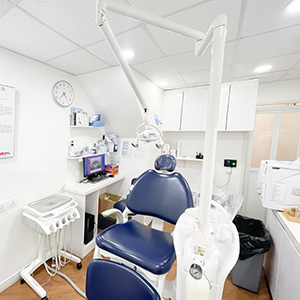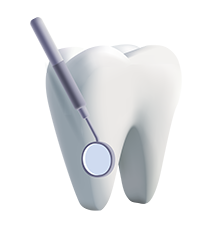Wisdom Tooth Extraction Surgery
Home > Oral Services > Advanced Dental Treatment – Wisdom Tooth Extraction Surgery

Wisdom Tooth Extraction Surgery
The myth that wisdom teeth are “pain-free and may be ignored” is widely held. However, in actuality, early-stage cavities and pericoronitis (inflammation of the soft tissues around the tooth crown) may not hurt, misleading patients into thinking their wisdom teeth are still in good condition. Severe discomfort may be experienced, however it can be too late by the time the cavity reaches the dental pulp. Wisdom teeth discomfort is not going to go away on its own. Root canal treatment or molar extraction may be required if cavities or pericoronitis damage the premolar teeth or the gum tissue surrounding them.
Impacted wisdom tooth can cause other serious issues in addition to dental problems including cavities and pericoronitis. In the most severe scenario, the impacted wisdom tooth may even cause the nearby teeth to become loose. In order to avoid these kinds of scenarios, considering wisdom tooth extraction could be an appropriate way to stop serious problems brought by the impacted wisdom tooth .
Treatment Process For Wisdom Tooth Extraction:
The treatment process for wisdom tooth extraction can be divided into two methods: non-surgical and surgical.
Non-Surgical Wisdom Tooth Extraction
Non-surgical wisdom tooth extraction is suitable for wisdom teeth that are visible in the oral cavity. First, the dentist will inject an anesthetic in the treatment area to ensure that you do not feel pain during the procedure. Then, the dentist will use dental forceps to loosen and remove the wisdom tooth. Finally, the dentist may perform socket debridement or bone smoothing as needed.
Surgical Wisdom Tooth Extraction
For wisdom teeth that are hidden beneath the gums or located close to the nerve, a surgical extraction may be recommended by the dentist. The surgery is typically performed under local anesthesia, but for more complex cases, general anesthesia or intravenous sedation may be necessary. After anesthesia is administered, the dentist will make an incision in the gum tissue, and sometimes remove surrounding bone if needed, to access and extract the wisdom tooth. In some cases, the wisdom tooth may need to be divided into several pieces for removal. Finally, the dentist will clean the socket, suture the wound, ensure hemostasis, and complete the surgical procedure.
Q&A
- What Is Wisdom Teeth?
- What Happens If You Don’t Fix Impacted Wisdom Teeth?
- Do I Need To Have My Wisdom Teeth Extracted?
- Does Wisdom Teeth Extraction Hurt?
- Can Both Sides/All Wisdom Teeth Be Extracted At Once?
- Will Extracting Wisdom Teeth Make My Face Look Smaller?
- Is It Necessary To Extract Wisdom Teeth Before Undergoing Orthodontic Treatment (Braces) If Wisdom Teeth Have Erupted?
- What Are The Risks And Complications Of Wisdom Teeth Extraction?
- What Should Be Noted After Wisdom Teeth Extraction Surgery?
- What Is A Dry Socket?
The wisdom teeth, sometimes referred to as third molars or wisdom teeth, are the backmost teeth in the upper and lower jaws and are one of the four large molars that usually erupt last in our mouths. Wisdom teeth typically erupt between the ages of 17 and 25, yet missing wisdom teeth are common.
Impacted wisdom teeth refer to teeth that cannot fit in the oral cavity, or those with problematic growth positions or angles, leading to tilted, horizontal, or completely buried teeth that cannot emerge from the jawbone, causing various dental problems and complications.
Wisdom teeth problems, like cavities or other dental diseases, are frequently more difficult to identify because of their location toward the back of the mouth. Because modern humans have comparatively smaller jawbones, impaction of wisdom teeth is common. Wisdom teeth issues that impact oral health may require consideration of extraction.
If your impacted wisdom teeth are causing pain and other symptoms, leaving them in place can be bad for your oral health. Impacted wisdom teeth are more prone to infection and abscesses — and they can cause damage, decay and disease to healthy teeth.
Pericoronitis
Symptoms of pericoronitis include swollen and painful gums, pus formation, bad breath, and in severe cases, facial swelling, difficulty opening the mouth, and fever. When the inflamed and swollen gums are stimulated by tooth occlusion, the condition worsens, making pericoronitis difficult to heal. Impacted wisdom teeth may also lead to cyst formation, causing damage to jawbone tissue.
Cavity
Cavities are another common issue because food debris and bacteria can easily accumulate in the crevices between wisdom teeth and adjacent teeth, making them difficult to clean with brushing, leading to the accumulation of dental plaque and increasing the risk of cavities.
May Lead To Root Resorption Of The Adjacent Tooth
An impacted wisdom tooth may continue pushing against the molar next to it. This can cause a “resorption cavity” where the wisdom tooth hits the other molar, causing the affected tooth to become loose.
Causing Other Teeth To Shift
Wisdom teeth typically grow in the furthest position in the mouth, and their growth direction may differ from the alignment of other teeth, such as growing horizontally or backward. When wisdom teeth grow, surrounding teeth may experience crowding, leading to teeth shifting position or changes in shape.
Dentists will assess whether you need to have your wisdom teeth extracted based on the following aspects:
Treatment Needs
- If you have had periodontitis or experienced facial swelling and infection due to wisdom teeth, dentists will recommend prompt extraction.
- If your wisdom teeth have cavities or have caused cavities or root resorption in adjacent teeth, dentists will advise wisdom teeth extraction and treat the corresponding complications to prevent the recurrence of problems caused by impacted wisdom teeth.
Preventive Considerations
If impacted wisdom teeth cause food debris to frequently accumulate in the crevices between the wisdom teeth and adjacent teeth, making it difficult to clean and potentially leading to cavities, periodontal disease, or gingivitis, even if the patient has not yet experienced complications of impacted wisdom teeth, wisdom teeth extraction should be considered.
You should not feel any pain during the extraction of wisdom teeth as the oral area will be numbed. However, if you do experience pain during the procedure, please inform your dentist so that they can provide you with additional anesthesia.
It is not recommended.
Extracting wisdom teeth may temporarily affect normal chewing, so dentists typically extract wisdom teeth from one side of the face at a time.
No, extracting teeth will not affect the cortical bone structure of the jaw (the bone tissue that supports the face). Unless undergoing orthognathic surgery or bone contouring to change facial shape, extracting teeth will not alter facial appearance.
It is not always necessary to extract wisdom teeth before undergoing orthodontic treatment (braces).
The reason for extracting wisdom teeth before starting orthodontic treatment is usually to avoid inflammation issues caused by wisdom teeth during the correction process. If you find that your wisdom teeth are impacted, you should consult your dentist as soon as possible to determine if wisdom tooth extraction is necessary.
There are some risks and complications associated with wisdom teeth extraction, as it is a minor surgical procedure.
The most common complications include facial swelling and pain, while other risks include postoperative bleeding, infection, root fractures, etc. There is a risk of damaging nearby nerves when extracting wisdom teeth, especially in the case of lower wisdom teeth removal. Before extracting wisdom teeth, it is important to communicate with your dentist to weigh the pros and cons of the extraction and make an informed decision carefully.
Swelling and pain may occur after the surgery, and typically this discomfort can last for two to three days.
The Following Tips Can Help Alleviate Post-Operative Discomfort And Expedite The Recovery Process:
- On the day of the surgery, avoid touching the surgical site, rinsing, and brushing your teeth.
- After the surgery, consume soft and cool foods and eat on the unaffected side of your mouth.
- 24 hours after the surgery, rinse your mouth with warm salt water to keep the surgical site clean. The ratio for the salt water solution is one cup of water with 1.5 teaspoons of salt.
- Starting the second day, if the wound has stopped bleeding, you can brush your teeth normally. Ensure good oral hygiene to prevent infection. Rinsing with warm salt water helps maintain oral cleanliness.
- Applying ice packs can help reduce swelling. Apply ice for about twenty minutes, then rest for twenty minutes. If your jaw feels sore or stiff after the swelling subsides, you can use warm compresses.
- During the recovery period, avoid excessive rinsing and aggressive tooth brushing. Also, avoid consuming hard or hot foods.
- If you experience pain, take pain medication as recommended by your doctor. Typically, pain and discomfort will gradually diminish within a week after the surgery.
- Avoid smoking, using straws, or spitting to prevent dislodging blood clots at the surgical site.
Please Contact Your Dentist As Soon As Possible If The Following Situations Occur:
- Continuous oozing or bleeding from the surgical site within 24 hours after surgery.
- Numbness in the tongue, chin, or lips persists three to four hours after surgery.
- Swelling worsens instead of improving.
- Fever, chills, or redness develop.
- Difficulty swallowing.
- Extreme pain at the tooth extraction site, which could be a symptom of dry socket.
Dry socket is a painful condition that can occur after tooth extraction. It happens when the blood clot that covers your wound becomes dislodged or doesn’t fully form. Dry socket treatments include pain relievers and placing medicated gauze over the affected area. Dry socket occurs after 2% to 5% of tooth extractions.
Symptoms Of A Dry Socket
- Dry socket typically occurs 3 to 5 days after a tooth extraction, rather than immediately. Pain may lessen when pain medication is effective, but it can intensify once the medication wears off, potentially radiating to one side of the face, jaw, ear, temple, or even the back of the head.
- There may be a foul odor emanating from the mouth, accompanied by changes in taste. Exposed white bone may be visible at the site of the wound, without the covering of granulation tissue.
Factors That May Lead To The Loss Of Blood Clot:
- Rinsing the mouth vigorously, spitting, or using a straw in excess after surgery
Smoking - Taking estrogen-containing medications (e.g., birth control pills)
- Pre-existing oral infection before surgery
- Larger surgical wounds or longer surgical duration
Preventive Measures To Reduce The Risk Of Dry Socket:
- Maintaining good oral hygiene before surgery to minimize inflammation around the tooth to be extracted
- Swallowing saliva and blood after surgery instead of rinsing or spitting excessively
- Using a cup instead of a straw for drinking during the first week following surgery
- Avoiding using hormone-containing preoperative medications
An experienced dentist can prescribe pain medication to relieve discomfort if it develops one to two days following tooth extraction. This is a common occurrence. It is crucial to get in touch with our healthcare providers right away for treatment if pain starts to radiate to the jaw, cheeks, or even the temple on the third or fourth day following the extraction and is severe.










